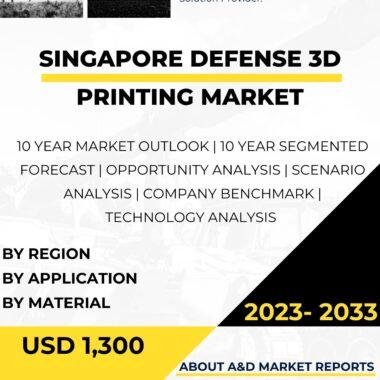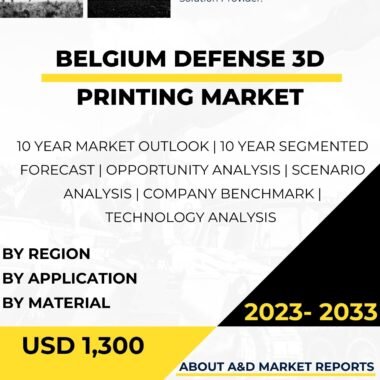Description
The defense 3D printing market in Sweden is a burgeoning sector that holds immense promise for transforming the country’s defense industry. As a nation with a strong commitment to technological innovation and military modernization, Sweden actively invests in indigenous 3D printing technology to ensure self-reliance, improve defense capabilities, and address emerging challenges in defense manufacturing.
3D printing, also known as additive manufacturing, is a revolutionary process that builds three-dimensional objects layer by layer, using computer-aided design (CAD) data as the blueprint. This technology allows for the creation of complex and customized components with reduced waste and lead times compared to traditional manufacturing methods. The defense 3D printing market in Sweden encompasses a diverse range of applications, including prototyping, rapid tooling, and end-use part production for military equipment and platforms.
Sweden’s investment in indigenous 3D printing technology underscores the country’s commitment to maintaining technological superiority and fostering innovation. By developing and integrating advanced 3D printing capabilities domestically, Sweden reduces its reliance on foreign suppliers and ensures a constant and reliable supply of critical components for its defense forces. Moreover, indigenous 3D printing development fosters technological advancements and stimulates the domestic defense industry, contributing to the country’s technological growth and economic development.
The defense 3D printing market in Sweden plays a vital role in improving the efficiency and performance of the country’s defense equipment. By employing 3D printing technology, defense manufacturers can rapidly prototype new designs, enabling faster iteration and validation of concepts. This agility is particularly valuable in the development of advanced military equipment, where quick adaptation to emerging requirements is essential.
Moreover, 3D printing enables the creation of complex geometries that are challenging or impossible to achieve using traditional manufacturing techniques. This capability allows for the production of lightweight, yet strong and durable, components for military platforms such as aircraft, armored vehicles, and naval vessels. The use of 3D-printed components can significantly reduce the weight of defense equipment, leading to improved fuel efficiency, increased payload capacity, and enhanced overall performance.
Saab Group, a renowned defense contractor in Sweden, is a key player in the country’s defense 3D printing market. With expertise in advanced materials and engineering, Saab has been at the forefront of developing cutting-edge 3D printing solutions for defense applications. Saab’s flagship projects, such as the 3D-printed parts for the Gripen E/F fighter jet and other military platforms, contribute significantly to Sweden’s defense modernization efforts and its military’s operational effectiveness.
The defense 3D printing market in Sweden also supports the country’s economic diversification and innovation. The adoption of 3D printing in defense manufacturing has implications beyond the defense sector, with potential applications in aerospace, automotive, and medical industries. The development of advanced 3D printing technologies and materials contributes to the growth of Sweden’s high-tech manufacturing capabilities and enhances its competitiveness in the global market.
As the defense 3D printing market continues to evolve, Sweden’s defense industry remains committed to advancing its 3D printing technology. Research and development efforts focus on improving the performance and properties of 3D-printed materials, exploring new applications for defense components, and increasing the scale and efficiency of the additive manufacturing process.
Furthermore, Sweden’s commitment to international cooperation and partnership drives the responsible export of defense 3D printing technology. Sweden adheres to strict export control regulations to ensure that 3D printing capabilities are provided to responsible partners seeking to enhance their own defense capabilities and contribute to global security and stability.
Despite its strengths, the defense 3D printing market in Sweden faces challenges that warrant careful consideration. One primary consideration is the need to strike a balance between traditional manufacturing methods and 3D printing. While additive manufacturing offers numerous advantages, it may not be suitable for all defense applications or may require complementary manufacturing techniques for certain critical components.
Moreover, ensuring the security and integrity of 3D-printed components is paramount, particularly in defense applications. As 3D printing technology becomes more accessible, there is a need to implement robust quality control and validation processes to ensure that printed components meet stringent defense standards and perform reliably in the field.
In conclusion, the defense 3D printing market in Sweden is a transformative sector that is reshaping the country’s defense industry. Sweden’s investment in indigenous 3D printing technology and its collaboration with companies like Saab Group demonstrate the nation’s commitment to technological self-reliance and innovation. The adoption of 3D printing in defense manufacturing leads to faster prototyping, lighter and more durable components, and improved defense capabilities for the Swedish Armed Forces. By addressing challenges proactively and investing in research and development, Sweden is well-positioned to maintain a leading edge in the global defense 3D printing market, supporting its defense needs and contributing to international peacekeeping and security efforts.




